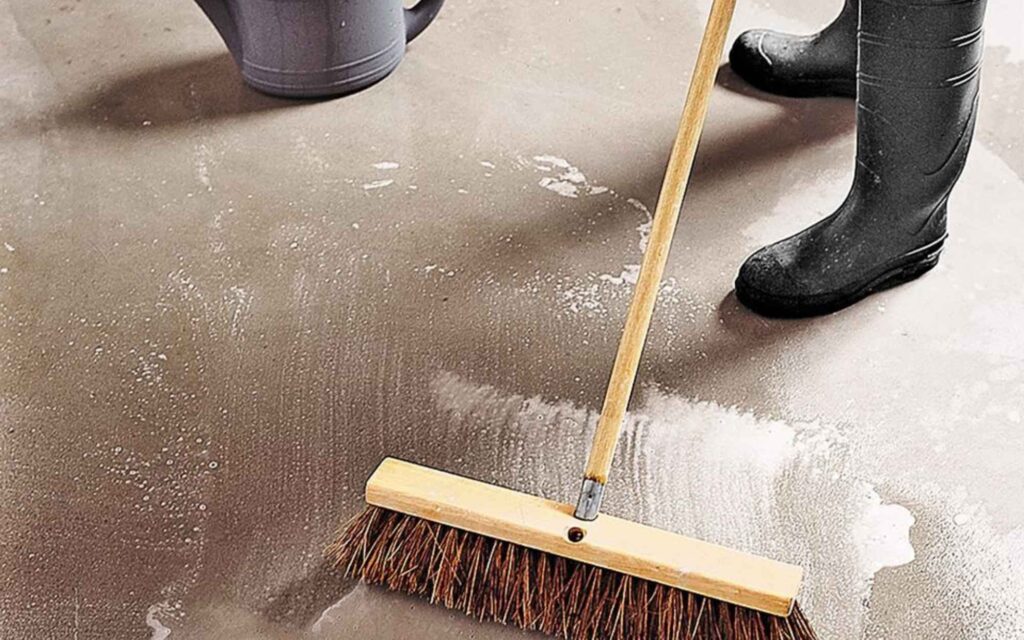Oil stains are a common nuisance in garages, especially if you’re working on cars, lawnmowers, or any machinery. Even after cleaning, these stains can leave permanent marks — unless your floor is sealed.As a concrete contractor with 20+ years in the field, I’ve seen firsthand how sealing concrete protects your investment, keeps maintenance simple, and prevents long-term damage. So let’s answer the big question
Why Oil Soaks into Unsealed Concrete
Concrete looks solid, but it’s highly porous. That means:
- Oil seeps into micro-gaps and pores
- Stains form below the surface
- Cleaning becomes harder the longer oil sits
If your garage floor is unsealed, even a single drop of motor oil can leave a dark, greasy spot that won’t come off easily — even with the best degreaser.
🧽 Already dealing with a stain? Read: How to Clean Oil Off Concrete Garage Floor
What Does Sealing a Garage Floor Actually Do?

A concrete sealer acts as a protective layer over the surface. It:
- Blocks oil, grease, chemicals, and moisture
- Makes the floor easier to clean
- Prevents permanent stains
- Enhances surface durability and shine
Some sealers are also UV-resistant, which helps prevent yellowing or fading in garages with sunlight exposure.
Types of Sealers for Oil Protection
There’s no one-size-fits-all. The best type of sealer depends on how your garage is used:
1. Penetrating Sealers
- Absorb into the concrete and block oil at the root
- Great for high-traffic garages
- Long-lasting with a natural finish
2. Acrylic Sealers
- Budget-friendly and easy to apply
- Form a protective film on the surface
- Good for short-term protection (1–2 years)
3. Epoxy Coatings
- Ultra-durable, glossy finish
- Ideal for heavy-use garages
- Completely seals the surface against oil, water, and chemicals
🧴 Want to know what products are best? Check out:
Best Products to Remove Oil Stains from Concrete Garage Floors
Should You Seal Before or After Cleaning?
Always clean the floor thoroughly before sealing. Otherwise, you’ll trap oil, dirt, and stains under the sealer, which can ruin the finish and reduce adhesion.
🧼 Learn more: How to Remove Oil Stains from Concrete: Best DIY Methods & Cleanup Tips
How to Seal a Garage Floor (Step-by-Step)
Step 1: Deep Clean the Surface
- Use a commercial degreaser to remove oil
- Pressure wash the floor
- Let the concrete dry completely (at least 24–48 hours)
Step 2: Choose Your Sealer
- For light DIY work: acrylic sealer
- For long-term durability: epoxy or penetrating sealer
Step 3: Apply the Sealer
- Use a roller or sprayer depending on product
- Apply in thin, even coats
- Let dry fully (follow manufacturer instructions)
Step 4: Apply a Second Coat (If Required)
- Optional, but increases protection and longevity
- Wait until the first coat is fully cured
❓
FAQs
Q1: How often should I reseal my garage floor?
It depends on the product. Acrylic sealers may last 1–2 years, while penetrating and epoxy sealers can last 5+ years with proper care.
Q2: Will sealing stop oil from staining completely?
Yes, as long as spills are cleaned promptly. Sealing gives you time to wipe up oil before it soaks in.
Q3: Can I seal a garage floor myself?
Absolutely. Most homeowners can apply acrylic or water-based sealers on their own. Epoxy may need more prep but is still DIY-friendly with the right tools.
Why Sealing Matters — A Contractor’s Perspective
After decades of fixing stained, cracked, and damaged garage floors, I can confidently say that sealing is your first line of defense. It keeps your concrete looking fresh, increases its life, and makes maintenance a breeze.



